21 Persei
| Observation data Epoch J2000 Equinox J2000 | |
|---|---|
| Constellation | Perseus |
| Right ascension | 02h 57m 17.28220s[1] |
| Declination | 31° 56′ 03.1871″[1] |
| Apparent magnitude (V) | 5.10[2] |
| Characteristics | |
| Spectral type | B9pSi[3] |
| U−B color index | -0.24[4] |
| B−V color index | -0.01[4] |
| Variable type | α² CVn[5] |
| Astrometry | |
| Radial velocity (Rv) | +8.50[6] km/s |
| Proper motion (μ) | RA: +2.55[1] mas/yr Dec.: -31.15[1] mas/yr |
| Parallax (π) | 10.20 ± 0.27[1] mas |
| Distance | 320 ± 8 ly (98 ± 3 pc) |
| Absolute magnitude (MV) | 0.14[2] |
| Details | |
| Mass | 3.57[7] M☉ |
| Luminosity | 88.65[2] L☉ |
| Surface gravity (log g) | 4.05[7] cgs |
| Temperature | 12,585[7] K |
| Metallicity [Fe/H] | +0.90[8] dex |
| Rotational velocity (v sin i) | 20[7] km/s |
| Other designations | |
| Database references | |
| SIMBAD | data |
21 Persei is a star in the constellation Perseus. Its apparent magnitude is 5.10. Located around 98.03 parsecs (319.7 ly) distant, it is a hot blue star of spectral type B9.[9] The star is an Alpha2 Canum Venaticorum variable, meaning that the star has a strong magnetic field chromium, silicon, and strontium spectral lines. 21 Persei's period is approximately 2.88 days[10]
References
- 1 2 3 4 5 Van Leeuwen, F. (2007). "Validation of the new Hipparcos reduction". Astronomy and Astrophysics. 474 (2): 653. arXiv:0708.1752. Bibcode:2007A&A...474..653V. doi:10.1051/0004-6361:20078357. Vizier catalog entry
- 1 2 3 Anderson, E.; Francis, Ch. (2012). "XHIP: An extended hipparcos compilation". Astronomy Letters. 38 (5): 331. arXiv:1108.4971. Bibcode:2012AstL...38..331A. doi:10.1134/S1063773712050015. Vizier catalog entry
- ↑ Hoffleit, D.; Warren, W. H. (1995). "VizieR Online Data Catalog: Bright Star Catalogue, 5th Revised Ed. (Hoffleit+, 1991)". VizieR On-line Data Catalog: V/50. Originally published in: 1964BS....C......0H. 5050. Bibcode:1995yCat.5050....0H.
- 1 2 Mermilliod, J. C. (2006). "VizieR Online Data Catalog: Homogeneous Means in the UBV System (Mermilliod 1991)". VizieR On-line Data Catalog: II/168. Originally published in: Institut d'Astronomie. 2168. Bibcode:2006yCat.2168....0M. Vizier catalog entry
- ↑ Samus, N. N.; Durlevich, O. V.; et al. (2009). "VizieR Online Data Catalog: General Catalogue of Variable Stars (Samus+ 2007-2013)". VizieR On-line Data Catalog: B/gcvs. Originally published in: 2009yCat....102025S. 1. Bibcode:2009yCat....1.2025S.
- ↑ Gontcharov, G. A. (2006). "Pulkovo Compilation of Radial Velocities for 35 495 Hipparcos stars in a common system". Astronomy Letters. 32 (11): 759. arXiv:1606.08053. Bibcode:2006AstL...32..759G. doi:10.1134/S1063773706110065.
- 1 2 3 4 David, Trevor J.; Hillenbrand, Lynne A. (2015). "The Ages of Early-Type Stars: Strömgren Photometric Methods Calibrated, Validated, Tested, and Applied to Hosts and Prospective Hosts of Directly Imaged Exoplanets". The Astrophysical Journal. 804 (2): 146. arXiv:1501.03154. Bibcode:2015ApJ...804..146D. doi:10.1088/0004-637X/804/2/146. Vizier catalog entry
- ↑ Wu, Yue; Singh, H. P.; Prugniel, P.; Gupta, R.; Koleva, M. (2010). "Coudé-feed stellar spectral library – atmospheric parameters". Astronomy & Astrophysics. 525: A71. arXiv:1009.1491. Bibcode:2011A&A...525A..71W. doi:10.1051/0004-6361/201015014.
- ↑ "LT Persei". SIMBAD Astronomical Database. Centre de Données astronomiques de Strasbourg. Retrieved 28 December 2013.
- ↑ Catalano, F. A.; Renson, P.; Leone, F. (1993). "Third supplement to the catalogue of observed periods of Ap stars" (PDF). Astronomy and Astrophysics Supplement Series. 98 (2): 269–273. Bibcode:1993A&AS...98..269C.
This article is issued from
Wikipedia.
The text is licensed under Creative Commons - Attribution - Sharealike.
Additional terms may apply for the media files.
